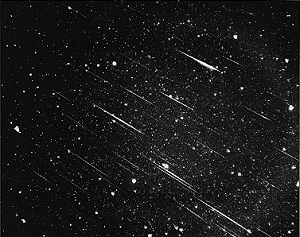For the first time the Leonids this year posed no surprises. And that's good news for those of us who are waiting to see a real meteor storm, because, based on this year's accuracy, the next two years will probably see even larger Leonids. The precise knowledge of the 1998 Leonid activity allowed scientists to predict the Leonid meteoroid stream with particular precision. The predicted time was November 18, 2h 08m Universal Time. The prediction was dead on. The map below proved to be very accurate, although the intensity was greater than expected, especially over Western Europe.
The following is a summary from NASA news:
November 18, 1999: "According to preliminary data reported by the International Meteor Organization and the Leonids Environment Operations Center, there was an intense outburst of Leonid meteors over Europe and the Middle East on Thursday morning, November 18. Maximum activity was recorded around 0200 UT as the Earth passed through the debris stream of comet Tempel-Tuttle.
"We observed many, many, many Leonids falling from the sky," said Casper ter Kuile of the Dutch Meteor Society, who was working with a team of observers located between Valencia and Alicante in Spain. "Our experienced visual observers counted about 30 Leonids per minute!"

The high rate noted by observers in Spain, over 1800 meteors per hour, was substantially greater than the 500 to 1000 per hour that most experts had predicted. The storm was even more intense over parts of the Middle East, where members of the Israeli Astronomical Association recorded 70 meteors per minute for just over a half an hour. Like other global observers, the Israeli team was struck by the abundance of faint meteors and the relative absence of bright fireballs. Preliminary reports by meteor watchers in the Canary Islands and near the Gorges du Verdon in France confirm this general picture of the outburst. The meteor storm was not seen west of the Atlantic. In North America sky watchers saw relatively few Leonids -- at most 40 to 50 per hour. The majority of these were fast-moving and dim. Radio measurements from Japan and the Czech Republic confirm the results of visual observers indicating a peak between 2:00 and 2:10 UT. This time coincides with the maximum at 2:08 UT predicted by Asher and McNaught. In their model of the Leonid meteoroid stream, the 1999 storm was caused by a dust trail created when the Leonids parent comet, Tempel-Tuttle, passed by the Sun about 100 years ago. The Asher-McNaught model successfully predicted even bigger Leonid storms in 2001 and 2002."
. (chart courtesy of International Meteor Organization)
|
|
|
|
|
|
|
|
|
|
|
|
|
|
|
|
|
|
|
|
|
|
